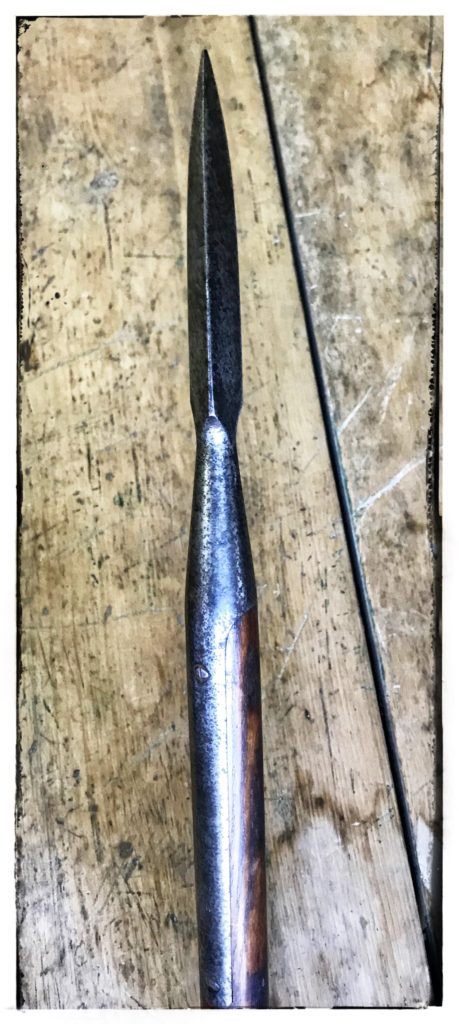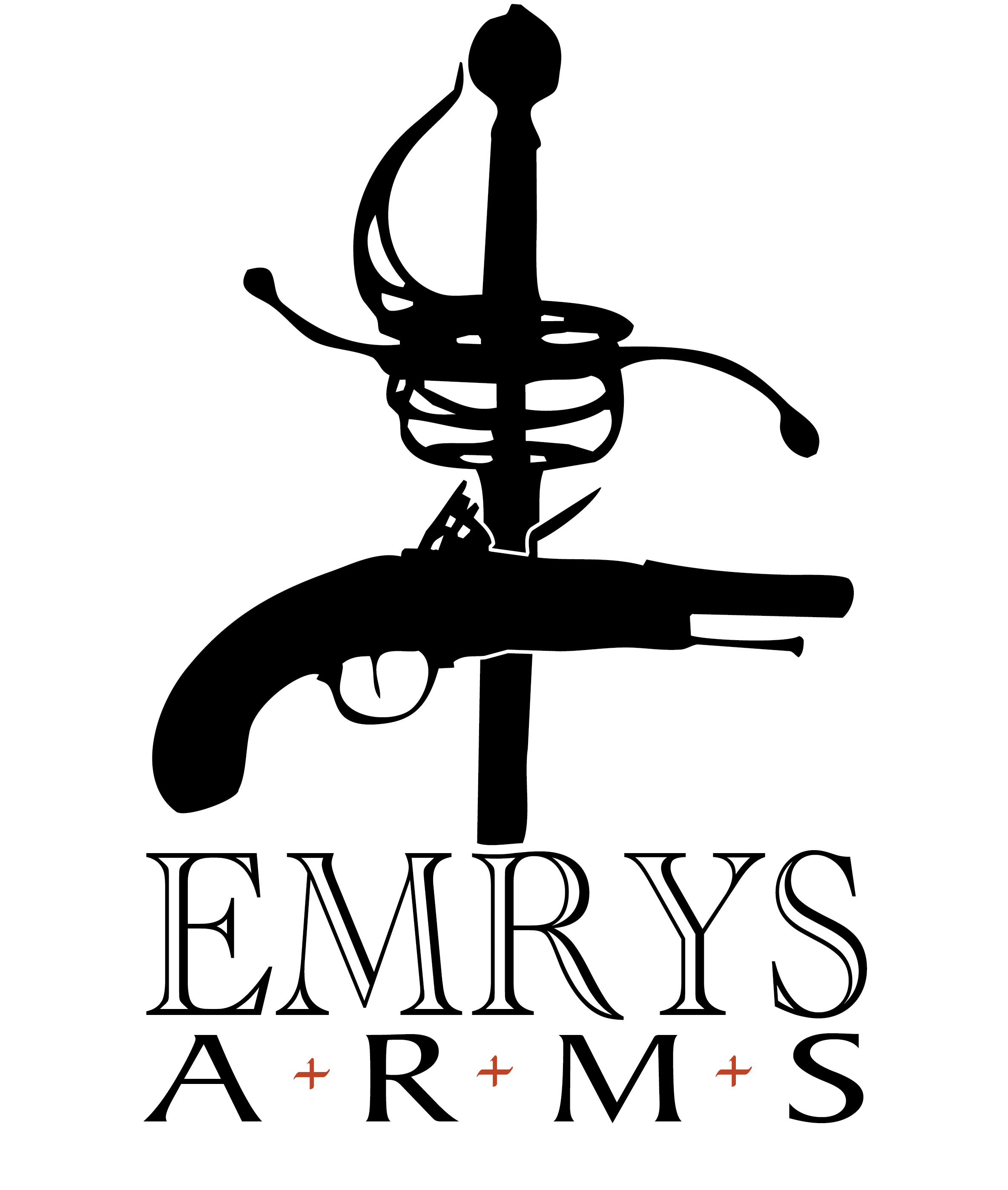| Collection #: | 2020.019 |
|---|---|
| Type: | Naval Pike |
| Nationality: | British |
| Pattern: | 1888 |
| Date: | 1898 |
| Spike: | Three Sided |
| Spike Length: | 12.5cm |
| Langet Length: | 19cm |
| Overall Length: | In three pieces: |
| 76.5cm - top piec to spike | |
| 77cm - both bottom pieces | |
| Regulation Length if in one piece - 228.6cm or 7' 6" |

Sometimes as a collector you have to learn to laugh at the mistakes you make. Sometimes you have to buy the best you can until you can upgrade to something better. This Naval pike has a story. However, to shorten it here, let’s just say that this Naval pike was purchased at auction in Hampton, New Brunswick. I did not look close enough at the pictures (though that may not have stopped me as Naval pikes do not come along everyday), and thought all three pieces would form one complete pike. Upon successfully bidding remotely and picking them up from the auctioneer, I discovered I had the remnants of two pikes. One spike end and two butt ends. There is more to the story, but needless to say, I still hope to find the remaining pieces someday…but it is a long shot.
I have not found a lot published on Naval boarding pikes, perhaps due to the lack of defined official patterns. Ian Skennerton mentions them as an interesting parallel to the cavalry lance in the List of Changes 5874 while giving a brief history of the lance in his booklet British Service Sword and Lance Patterns. For those interested in the differentiation between a lance and a pike, a simple explanation put forth by Skennerton is that if used on horseback, it is often referred to as a lance and if used by footmen, it is often referred to as a pike (page 35).
– Skennerton, Ian. Small Arms Identification Series No. 6 – British Service Sword and Lance Patterns. Page 35.
Perhaps the most information and one of the accepted authoritative sources on Naval edged weapons and pikes is William Gilkerson. He briefly discusses the introduction of the 1888 pattern as the first formally introduced Naval pike pattern, while also describing the evolution of the butt shoe. In discussing the previous unofficial pattern of British Naval pike which had a pointed butt shoe he relates that “some of these pikes were evidently corrected, for many are found with the points of their butt shoes cut off, leaving a collar or ferrule through which protrudes a knob of the staff. This modification was formalized on the boarding pike of 1888, for which the British navy at last decreed an officially designated pattern. This only “model” was 7’6” long with a triangular section spike head and langeted butt collar… The model of 1888 continued in production throughout the century and many are still around. They are usually seen with the last two digits of their 1890’s dates die-stamped onto their langets … The boarding pikes still remaining aboard Royal Navy ships in 1926 were finally called back into store in that year and issued for decorative display to naval offices and museums”.
In earlier reference to the butt shoe being cutdown, apparently some naval pikes, similar to their lance cousins, had a pointed butt shoe. However the pointed butt shoe was prone to chewing up the decking or possibly injuring a comrade in the close confines of the ship. It is an expensive and hard book to find, but worth it. For more additional information on Naval pikes also check out The Pirates Lair.
As to the specifics on this particular example, starting with the spike ended section. It consists of a formidable three sided spike which grows for 11cm before abruptly shrinking down to the collar. The collar is about 7cm and gradually increases to the diameter of the shaft. from there, a langet on either side extends down the shaft about 9cm. On langet number one with one screw securing it and terminating in the langet on the opposite side is a rack number 16. On the other langet with two screws terminating in the langet on the opposite side, is an N denoting a Naval designation. Under that is a broad arrow with EFD showing its Enfield manufacturing and government ownership. Beneath that is a crown over 66 over E, showing that it was viewed by inspector 66 at Enfield and finally below that we have its issue date of ’98 for 1898.
Butt end number one (and most likely the piece belonging to the spike end) is also marked on the butt shoe langet with a broad arrow over EFD and below that we have the corresponding inspection stamp of a crown over 66 over E. Stamped into the wood above the langet is another crown surmounting the number 14 over E for (re)inspection at Enfield, unless someone else inspected the wooden shaft. On the reverse side above the langet in the wood is another inspection stamp of a crown over 1 over M. I cannot at this time confirm who M represents, but it could be for Mole, one of the remaining prominent sword manufacturers along with Wilkinson at this time. Above this marking in the wood is another indecipherable stamp. Basing it off of the other butt end section which has the number 10, I am guessing it is a number – perhaps 8?
The second butt end is marked on its langet with a broad arrow over EFD followed by a crown over 30 over E. Above the langet, in the wood is a crown over 1 over M and above that is the number 10. I am unsure as to what the 10 may represent as it seems too small to be referring to a rack number. On the reverse side above the langet, stamped in the wood is a crown over 14 over E. This concludes the markings of these pieces.
In displaying this piece for the exhibit I created, I purchased a piece of doweling with a matching diameter and cut it to the missing length. I left the doweling blond so that viewers could see what was original and what was in place to provide representation as to the original length of the pike.

